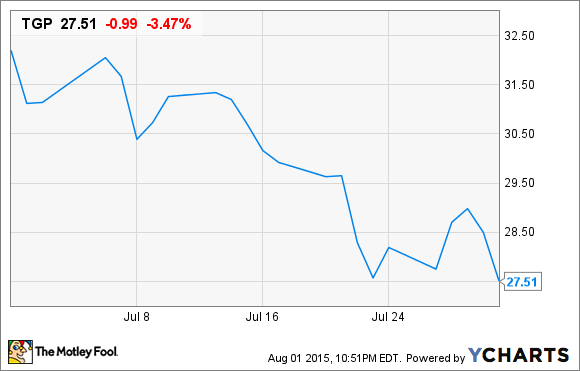Shares of Teekay LNG Partners (TGP), a limited partnerships consisting of 56 owned, 3 in-chartered, and 27 newbuild vessels involved in the seaborne transportation of liquefied natural gas (LNG), liquefied petroleum gas (LPG), and crude oil, declined 15% in July based on data from S&P Capital IQ. The culprit appears to ongoing weakness in LNG pricing in overseas markets.
In Japan, liquefied natural gas prices have been tumbling at an alarming rate. Since breaching the $15/MMBtu level in February, LNG prices ended June at just $9.50/MMBtu. As a whole, LNG prices to Asia have tumbled by roughly 65% from their peak in early 2014 as the premium typically assigned to LNG prices being shipped to "far away Asia" has disappeared. With new LNG production expected in the U.S. and Australia in the second half of this year, and supply expected to begin catching up with demand, LNG prices over in Asia have corrected sharply lower.
In addition, Asian countries such as China have made big bets on other alternative energies, such as solar power. China's desire to have 35 GWs of solar production by the end of this year, and its willingness to help fund domestic solar panel manufacturers to make that happen, has weighed on LNG prices for fear that future demand may not be as robust as once believed.

Source: Teekay Corporation via Flickr.
The real question that investors need to ask here is whether these sinking LNG prices in Asia are a genuine cause for concern for Teekay LNG Partners, or if investors have overreacted.
The good news for investors is that the Partnership appears pretty healthy. A majority of its shipping contracts are geared for the long-term, which means that Teekay LNG Partners is only minimally exposed to the wild fluctuations in LNG prices in overseas markets such as Asia. These contracts are also fixed-rate, which means predictability in terms of cash flow and profits. What this really means is Teekay LNG Partners has allotted plenty of time for LNG supply and demand to tighten and prices to stabilize before it'll need to renegotiate contracts for its fleet.
Additionally, Teekay LNG Partners has a robust newbuild fleet of 27 vessels which will keep the partnership competitive as older vessels from competitors are slowly taken out the rotation. New vessels command premium rates since they're typically more efficient and spend less downtime being repaired and maintained.
It's certainly not out of the question that Teekay LNG Partners' roughly 10% dividend yield could decline in future quarters if the company has to negotiate new contracts with LNG prices substantially lower than in previous years. But, for the intermediate future at least, I'd suggest that a good chunk of its profits look well-protected, and that this drop could represent an intriguing buying opportunity for income investors with a higher than average appetite for risk.





